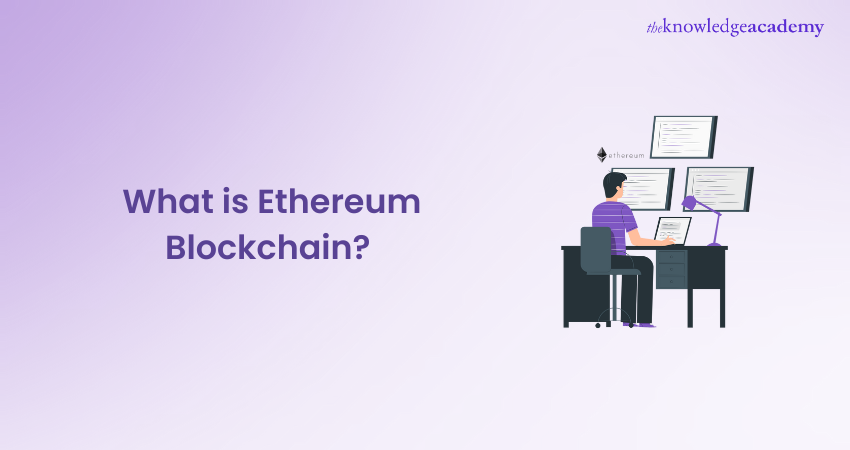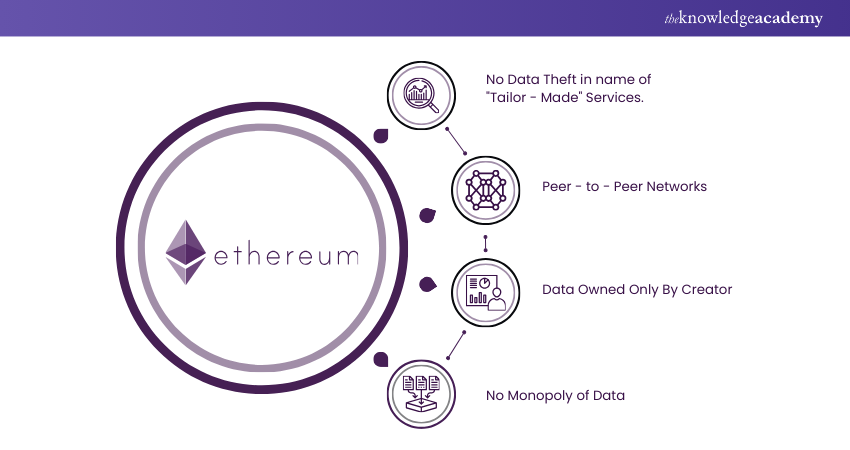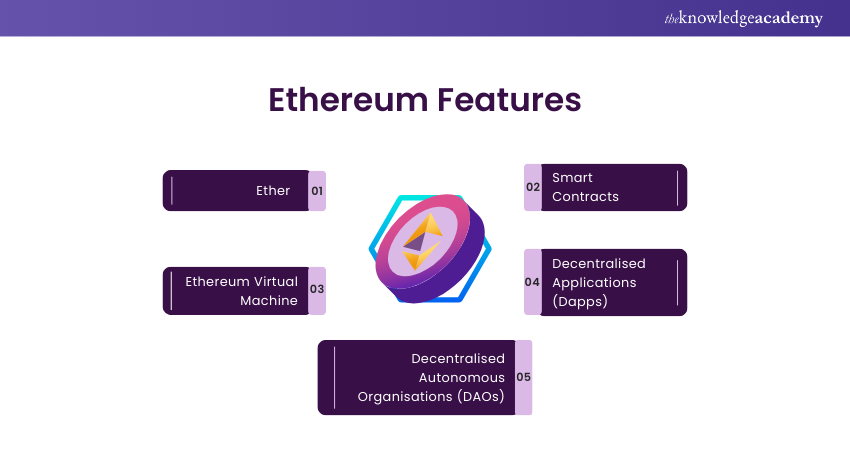We may not have the course you’re looking for. If you enquire or give us a call on 01344203999 and speak to our training experts, we may still be able to help with your training requirements.
Training Outcomes Within Your Budget!
We ensure quality, budget-alignment, and timely delivery by our expert instructors.

Ever wondered how a single technology could revolutionise finance, gaming, art, and social media simultaneously? Well, Ethereum is the answer to all your questions. But what is Ethereum exactly? It is not just a Cryptocurrency but a decentralised global software platform fueled by Blockchain technology. Its incredible versatility lets users make transactions, earn interest, store NFTs, trade Cryptocurrencies, and immerse themselves in virtual worlds.
In this blog, we will explore the question “What is Ethereum’ and how it works, its long-trailing history, exclusive features, ways to buy, use cases, and the future. It's time to set our knowledge voyage toward the Blockchain horizon and uncover the wonders of this game-changing technology.
Table of Contents
1) Decoding What is Ethereum?
2) History of Ethereum
3) How does Ethereum Work?
4) What is Ethereum 2.0 (Eth2)?
5) How to Buy Ethereum?
6) Use Cases of the Ethereum Blockchain
7) Why Should you use Ethereum?
8) Conclusion
Decoding What is Ethereum?

Ethereum is the second most popular Cryptocurrency, just behind Bitcoin. It is a form of digital currency available exclusively online. It operates on its own Blockchain platform, known as the Ethereum Blockchain, which is a decentralised network of computers. This distributed ledger technology, commonly referred to as Blockchain, manages and tracks transactions and Smart Contracts associated with Ethereum.
Blockchain is made up of nodes which are the volunteer computers used to mine coins.These nodes produce Ether tokens through the mining process called Cryptography. Since mining demands using a computer’s resources and puts intense pressure on the computer, the miners are rewarded with Ether.
Ethereum is perceived to be like Bitcoin. However, unlike Bitcoin, the Ethereum blockchain was not originally created as digital money.
History of Ethereum
Here’s a roadmap for Ethereum’s History and Development
a) Introduction to Ethereum
a) 2013: Vitalik Buterin publishes the Ethereum whitepaper.
b) Co-founders: Gavin Wood, Jeffrey Wilcke, Charles Hoskinson, and others join Buterin.
b) Purpose and Vision
a) Addressing Bitcoin’s Limitations: Ethereum aims to overcome Bitcoin’s limitations.
b) Development of DApps: Enabling decentralised applications to work together on the Blockchain.
c) Vitalik Buterin’s Vision: Integrating DApps for widespread adoption and seamless operation.
c) Ethereum 1.0
a) Decentralisation: No central control; community-driven decisions within DApps.
b) Embedded Rules: Network rules enforced by Blockchain Developers.
d) The DAO (Decentralised Autonomous Organisation)
a) 2016 Launch: DAO is created to manage network changes and proposals through voting.
b) Avoiding Central Authority: Decisions made by a group rather than a single authority.
e) Security Incident and Hard Fork
a) DAO Hack: A hacker steals £33 million.
b) Hard Fork Decision: Community votes to upgrade to a new network.
c) Ethereum Classic: The original chain continues as Ethereum Classic.
d) New Ethereum Fork: Establishment of the new Ethereum network.
Aspiring to become a Blockchain expert - Join Blockchain Training Course today!
How Does Ethereum Work?
Similar to Bitcoin, a network in Ethereum resides on nearly thousands of computer systems worldwide. The credit for the network's operation and existence goes to the users involved as 'nodes' instead of a centralised server. This turns the network into a decentralised kind and is very resistant to external attacks. As a result, the network does not go down, which means that other nodes will remain functional despite any one system or 'node' failing.
Amidst the network of Ethereum is the Ethereum Virtual Machine or 'EVM', which is a computer run by the decentralised system. Every existing node on the network holds a copy of that computer, which means that any and all exchanges must be verified so that all nodes can make updates to their copies of the EVM. These exchanges are also considered 'transactions' and contained within blocks existing on the Ethereum Blockchain.
These blocks do not get to go on the network before confirmation or validation from the miners, providing transaction history. Verifying transactions through mining is known as the Proof-of-Work (PoW) consensus method. Every block has a unique identification code of 64 digits. Miners are required to obtain that code and prove that it is unique. The computer power invested in this process is a testament to their work. When that proof gets verified, miners get paid in ETH.
The way they get paid is another story altogether. Every transaction is accompanied by a sum called 'gas'. Whoever initiates the payment has to pay the gas, which is the same thing paid to miners. The objective of gas is to limit the actions a user can perform per transaction and avoid network spam.
There is a limit to the gas that a block can hold, as this differs with transaction type and amounts. Thus, depending on network activity, the price of gas can get a bit high for some users. Due to this, users are always on the run to be the first to validate transactions. As a result, the network gets busy and boosts fees higher than before.
Cryptocurrency is required to link with Ethereum. It is stored in blockchain wallets that are connected to Dapps. Using them, the users can do whatever they like, whether lending money or playing games. Cryptocurrency acts as data here, allowing users free browsing and anonymous interactions. This points to how non-discriminatory the DApps are. For instance, no banking Dapp can be rejected because of race or financial condition of the user. The users are in control, which is one feature that associates Ethereum with the word "the future of web interaction."
Cryptocurrencies like Bitcoin, Ethereum, and many more are based on blockchain technology. Learn the structure and mechanisms of blockchain with the Blockchain Training course!
What is Ethereum 2.0 (Eth2)?
Ethereum 2.0 is an upgraded version of the Ethereum network, transitioning from the Proof-of-Work (PoW) model to the Proof-of-Stake (PoS) model. This upgrade addresses many of the technical challenges faced by the original Ethereum system. The Ethereum Foundation refers to the original Ethereum as ‘ETH 1.0’ and Ethereum 2.0 as ‘ETH2’, representing the execution and consensus layers, respectively.
Key points about Ethereum 2.0:
a) Need for Ethereum 2.0:
a) Growing blockchain awareness has led to increased network activity.
b) Higher transaction fees and slower validation times have become common issues.
c) Ethereum 2.0 aims to resolve these challenges with new features like the Beacon Chain and PoS consensus algorithm.
b) Gradual Implementation:
a) Ethereum 2.0 is being implemented over time, not as a one-time event.
b) It introduces two essential features: the Beacon Chain and the PoS consensus algorithm.
c) Beacon Chain:
a) The Beacon Chain is one of the first features of Ethereum 2.0.
b) It facilitates necessary changes for future upgrades.
c) Shard Chains, a part of this upgrade, distribute transactions across smaller blockchain networks to clear network congestion.
d) Proof-of-Stake (PoS) Consensus Algorithm:
a) PoS offers a more accessible and faster form of blockchain consensus.
b) Validators, instead of miners, perform tasks like storing the Ethereum blockchain and validating transactions.
c) PoS does not require unique and heavy hardware, unlike Cryptocurrency mining.
d) Any user with sufficient funds and a device can participate, increasing accessibility and appeal.
e) As the number of validators grows, more blocks get validated, ensuring network growth and further decentralisation of Ethereum.
Boost your job search with these Blockchain Interview Questions and Answers!
How to Buy Ethereum?
Cryptocurrencies cannot be purchased from regular brokerage sites on the internet.They can only be availed from a Cryptocurrency trading platform. Depending on your trading persona. You can access several different cryptocurrency exchanges present today. This can include a simple dashboard and sometimes a slightly more challenging one. Below, we have described four key steps to buy Ethereum:
1) Choose a Cryptocurrency Exchange: Select a reputable platform where you can buy Ethereum. Popular exchanges include Coinbase, Binance, Kraken, and Bitfinex.
2) Fund Your Account: Deposit funds into your exchange account using methods like bank transfers, credit cards, or Cryptocurrency deposits.
3) Order Your Ethereum: Place an order to buy Ethereum on the exchange. You can choose a market order (buy at the current price) or a limit order (buy at a specific price).
4) Store Ethereum: After purchasing, transfer your Ethereum to a secure wallet for safekeeping. This can be a software wallet, hardware wallet, or a wallet provided by the exchange.
Use Cases of the Ethereum
Image Description: Diagram describing the use cases of Ethereum using infographics
Ethereum is becoming a common part of every person’s life, mainly due to the increasing use of Cryptocurrencies. Here are a few of the use cases of Ethereum in modern life.
a) Ethereum’s Utility in the Healthcare Sector – Hospitals and doctors keep a record of their patients. However, it becomes challenging for patients to share this information if they shift locations. Currently, there is no centralised system where such data can be stored, accessed, and utilised. However, Ethereum can modify this situation and provide medical professionals with this data, allowing them to monitor health closely.
b) Ethereum as a Digital Identity – Ethereum can be used to check the authenticity of identity-related documents such as passports, licenses, and others through online mode. Due to the increasing internet-related risks, governments cannot verify a person's identity online. However, Ethereum can change that by providing authorities with a fast and reliable method for verifying people's identities online.
c) Ethereum for Data Privacy – Modern-day companies and even search engines are storing users' personal data to make billions of pounds in profits. However, Ethereum’s Blockchain technology can be used to make such data collection an arduous task. Ethereum platforms log every time search engines store and use the user's data. It also makes these logs publicly accessible, enabling the users to to determine whether businesses are employing their information.
Create and deploy your tokens seamlessly with our curated Ethereum Developer Training Course.
Why Should You Use Ethereum?
With an increasing use cases, Ethereum is becoming an integral part of everyday modern life. Here are a few reasons behind using Ethereum:
Quicker and Cheaper Cross-Border Payment
With stablecoins such as Tether and US Coin (USDC), based on Ethereum, cross-border payments have become quicker and cheaper. In addition, global payment systems can be made stable and affordable with Ethereum Blockchain.
Quicker Help in a Time of Need
During the time of emergencies, such as the current Russia-Ukraine war, Cryptocurrencies like Ethereum have emerged as a means for the Ukrainians to stay connected with the outside world and gain access to quick and reliable money.
Ethereum Features
Before getting deeper into the world of Ethereum, it’s important to ascertain a few of its basic features. Here is a list of those Ethereum features:

Ether
Ether (ETH) is the digital currency of Ethereum. The computational resources and transaction fees that occur on the network are paid using Ether. It can be described as the peer-to-peer currency, which is also used to buy gas. Any transaction on the Ethereum network is made using gas. So, to run transactions on the network, you need gas, which can be acquired by paying in Ether currency.
Smart Contracts
Smart Contracts, like regular contracts, contain mutually decided rules and regulations to assist the exchange of assets between two or more parties. The assets could be money, property, or even digital assets. This can be created through any Ethereum user.
Smart Contract executions are decentralised. This means that anonymous parties in the network handle processes like verification instead of a central authority.
Additionally, using Smart Contracts entails a lot of benefits. It provides a safe environment for transparent transactions and secures the identities of either party. Furthermore, the sender and receiver accounts are notified upon successful transaction completion.
Ethereum Virtual Machine (EVM)
Ethereum Virtual Machines (EVMs) provide the foundational software that helps understand Smart Contracts concisely and allows users to interact with them. Moreover, solidity-based Smart Contracts can be interpreted with EVMs.
EVM works in a sandbox environment – isolated virtual machines where potentially unsafe codes can be executed without impacting the entire network. It allows the testing of Smart Contracts multiple times until you can verify them. If you are content with its performance, you can position it on Ethereum's central network.
Decentralised Applications (Dapps)
Logging into a typical Blockchain Application requires an Application Programming Interface (API) to access the centrally hosted data. On the other hand, decentralised applications use Smart Contract-based API to collect the data you desire from the blockchain network.
This Blockchain network is decentralised, where all transactions that occur in the network are verified by miners using the Smart Contract. The software for Dapp does not rely on a centralised authority and, as a result, provides a direct link between end-users and Dapp providers. When open-source applications use public Blockchain-based tokens to run, it is considered a Dapp. They rely on these tokens as fuel to function.
Decentralised Autonomous Organisations (DAOs)
The DAO is a decentralised organisation that collectively votes to introduce or remove necessary changes to the network. It consists of a designated group of people who function democratically. The regulations in a Smart Contract command DAOs, who use the contracts for decision-making.
The DAO has an efficient and concise voting process. This starts with funding the Dapp so that it can execute. A token is provided to each member that represents the share percentage of that person in the DAO. These tokens are used to vote in the organisation, and the maximum votes lead to a decision.
Future of Ethereum
The Ethereum Developers have catalysed the rising popularity of the Ethereum Blockchain by creating decentralised finance projects and NFTs. These new applications have raised network traffic tremendously, attracting more developers to Ethereum.
Unfortunately, these factors are insufficient to provide Ethereum with a hassle-free future. One significant drawback is the lag in technological upgradation. This puts Ethereum at a disadvantage amongst its competitors and the ever-growing crypto world. In addition, the recent uprise of Bitcoin might also affect Ethereum's significance.
Conclusion
After reading this blog, we hope you can understand what Ethereum Blockchain is and its uses in modern life. Cryptocurrencies like Ethereum have become a means for people to earn passive income and capitalise on the best of the market situation. The best part is it is versatile, and everyone can adapt to Cryptocurrencies such as Ethereum as their career choice to develop a robust financial portfolio.
Frequently Asked Questions

Ethereum makes money through transaction fees for processing operations, token creation, DeFi services, and NFTs. For Ethereum 2.0, users also earn rewards by staking ETH to secure the network.

Whether Ethereum is better than Bitcoin depends on certain aspects. Ethereum offers versatility and supports Smart Contracts and DApps. In contrast, Bitcoin is more focused on being a stable digital currency. Secondly, Ethereum's transactions are generally faster and cheaper, while Bitcoin relies more on security and stability.

The Knowledge Academy takes global learning to new heights, offering over 30,000 online courses across 490+ locations in 220 countries. This expansive reach ensures accessibility and convenience for learners worldwide.
Alongside our diverse Online Course Catalogue, encompassing 19 major categories, we go the extra mile by providing a plethora of free educational Online Resources like News updates, Blogs, videos, webinars, and interview questions. Tailoring learning experiences further, professionals can maximise value with customisable Course Bundles of TKA.

The Knowledge Academy’s Knowledge Pass, a prepaid voucher, adds another layer of flexibility, allowing course bookings over a 12-month period. Join us on a journey where education knows no bounds.

The Knowledge Academy offers various Blockchain Training, including the Blockchain Training Course, and Ethereum Developer Training. These courses cater to different skill levels, providing comprehensive insights into the Trading Ethereum.
Our Advance Technology Blogs cover a range of topics related to Ethereum and Blockchain Technology, offering valuable resources, best practices, and industry insights. Whether you are a beginner or looking to advance your Blockchain Skills, The Knowledge Academy's diverse courses and informative blogs have got you covered.
Upcoming Programming & DevOps Resources Batches & Dates
Date
 Blockchain Training Course
Blockchain Training Course
Thu 6th Feb 2025
Thu 3rd Apr 2025
Thu 5th Jun 2025
Thu 7th Aug 2025
Thu 2nd Oct 2025
Thu 4th Dec 2025







 Top Rated Course
Top Rated Course



 If you wish to make any changes to your course, please
If you wish to make any changes to your course, please


